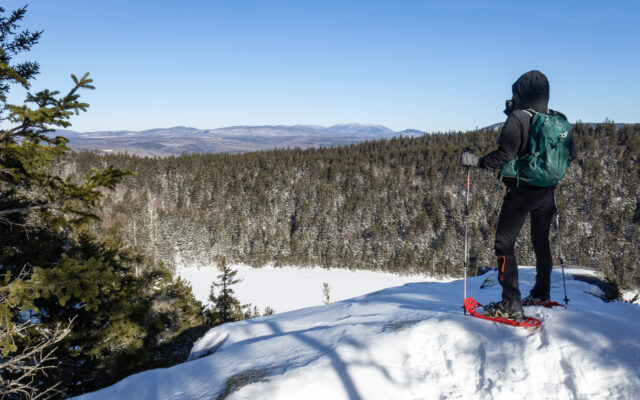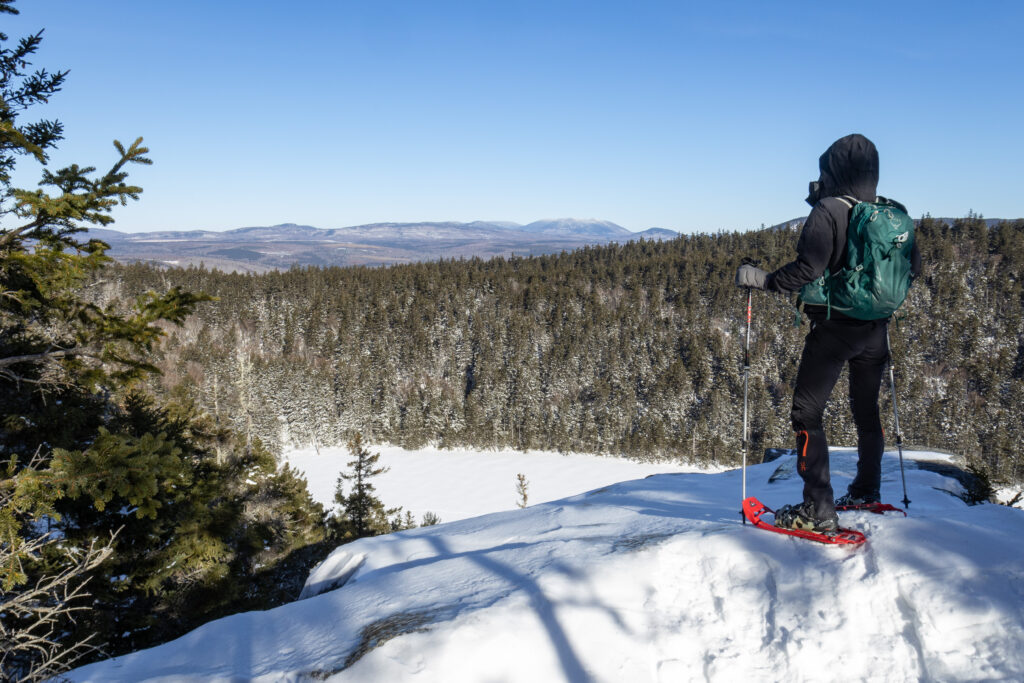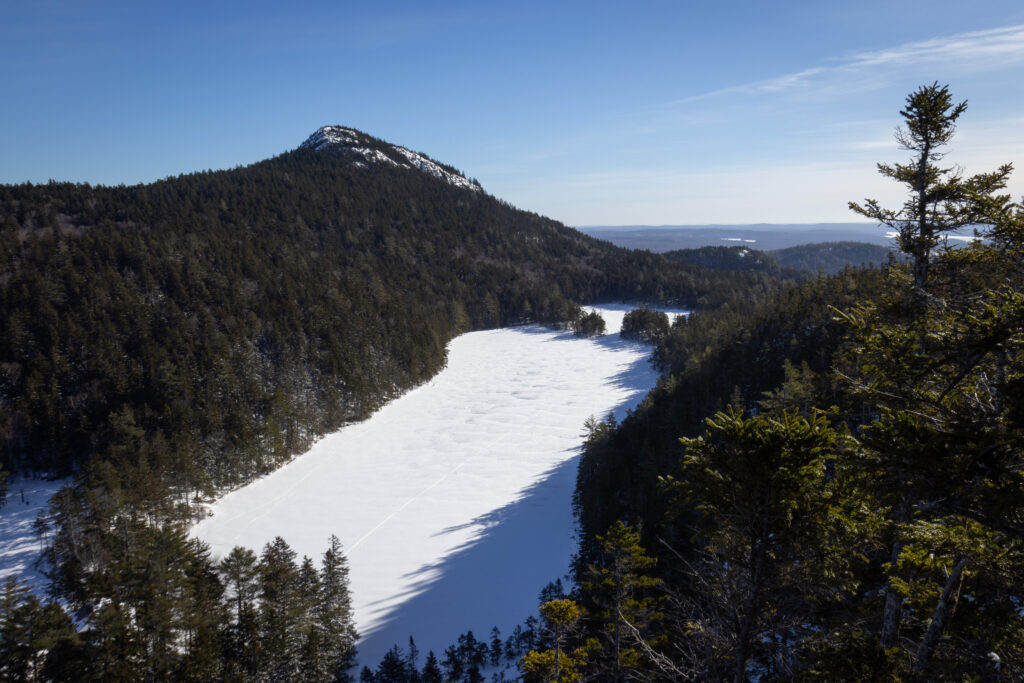
This overlooked hike has a surprise at the end of the trail
By Aislinn Sarnacki
“Beware!” a sign reads at the trailhead for Peregrine Ridge.
The trail ends at the edge of a dramatic cliff, the hand-painted sign goes on to explain. The ledge can be slippery when wet. “Keep children nearby.”
On that frigid January day, I was alone, with no children or dogs to keep back from the sheer drop. I’d hiked in the area many times, but it was my first exploration of Peregrine Ridge.
It’s an easy trail to overlook.

SELF PORTRAIT — Aislinn Sarnacki stands at an overlook on Peregrine Ridge on Jan. 19, at Borestone Mountain Audubon Sanctuary. This is a self portrait. The camera is balanced on the branches of a tree.
Deep in Maine’s 100-Mile Wilderness region, Peregrine Ridge is located in the 1,600-acre Borestone Mountain Audubon Sanctuary.
Most people visit the property to hike to the top of Borestone Mountain, and for good reason. It’s a spectacular hike.
But along the way, hikers pass by the trailhead to Peregrine Ridge, and I bet many don’t even notice.
I didn’t.
I’ve hiked Borestone Mountain several times, yet it wasn’t until this winter that I spotted the dark green sign that marks the adjoining Peregrine Ridge Trail. Fastened to a tree trunk at the edge of a shady forest, it somewhat blends into its surroundings.
Judging by the lack of footprints in the snow, no one had hiked the trail in a while.

PEREGRINE RIDGE — The overlook at the end of Peregrine Ridge Trail offers a view of Borestone Mountain on Jan. 19, as well as the frozen Midday and Sunrise ponds
It’s important to note that Borestone Mountain Audubon Sanctuary isn’t staffed in the winter. You are on your own if you visit. Preparation is key. It’s a remote location with unreliable cell phone service.
Even experienced hikers carrying plenty of survival gear can get into trouble. To increase my safety on the adventure, I carried a satellite tracker that would allow me to send messages in case of an emergency. I also told someone where I was hiking and when I expected to return.
In the winter, these extra safety measures are especially important because low temperatures add an element of danger.
On that particular day, it was so cold that my hands started burning within seconds of me removing my mittens. Condensation formed little beads of ice on my eyelashes.
To hike to the summit of Borestone Mountain or Peregrine Ridge (or both), you start at the same gravel parking lot not far from Big Wilson Falls. From there, you can either hike up a 1.3-mile access road (unplowed in the winter) or the 1.1-mile Base Trail to the Visitor Center at the shore of Sunrise Pond.
That’s where the hikes diverge.
As you look out over the tranquil pond, the way to the summit of Borestone Mountain is to your right, while the trail to Peregrine Ridge is to your left, across from the visitor center.
Peregrine Ridge Trail is just half a mile long, dead-ending at a breathtaking overlook atop the cliffs. The out and back trek is about 3.2 miles if you start by hiking the Base Trail, or it’s 3.6 including the access road.
What makes this little-known hike worth doing?
As I broke trail with my snowshoes in January, I marveled at the beauty of the forest on Peregrine Ridge. Fern-covered boulders and towering evergreens reminded me that I was deep in the wilderness, surrounded by nature.
About 0.2 mile into the hike, I came across a side trail that’s only open to sanctuary staff. It provides access to lodges that the Audubon rents during warmer months.
The most obvious highlight of the hike is the overlook at its end. From the edge of the cliff, you can look out over Sunset, Midday and Sunrise ponds. Borestone Mountain rears to the east, while to the north and west, the wilderness stretches to mountains and hills around Moosehead Lake.
As an amateur birder, the name Peregrine Ridge interested me. Peregrine falcons are listed as endangered in Maine, and I’ve never actually seen one outside of the pages of a guidebook.
I reached out to the folks at the Maine Audubon, who told me that peregrines don’t currently nest on the cliffs of Peregrine Ridge, but they do have a history there.
In the 1980s and 1990s, the state conducted a peregrine reintroduction program that involved “hacking.”
This is a practice where young captive-bred peregrines are gradually returned to the wild by being acclimated in a protective box on the edges of cliffs until they’re old enough to fly. During that time, they’re fed through a food chute so they don’t see their human caretakers.
Peregrine Ridge was one of these “hacking” sites.
A total of 153 young peregrines were reintroduced to Maine between 1984 and 1997. And in recent years, adult peregrines have been seen nesting on the nearby cliffs of Barren Mountain.
Borestone Mountain Audubon Sanctuary is open to hikers from dawn until dusk, but facilities such as toilets are closed in the winter.
If you are not a member of the Maine Audubon, you must pay a trail use fee. It’s $5 for adults and $3 for students, seniors and school group participants. Dogs aren’t permitted. For information, visit maineaudubon.org.